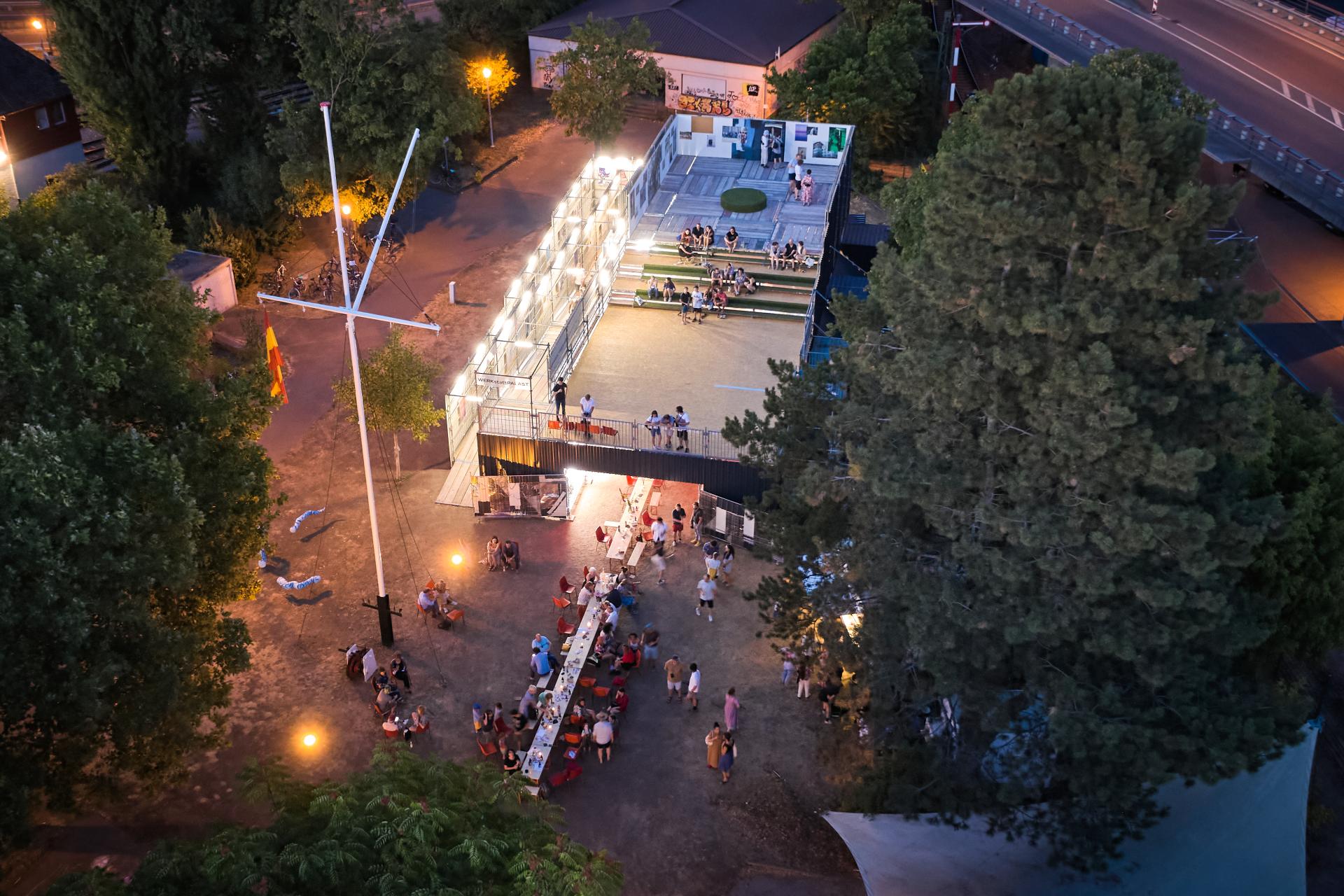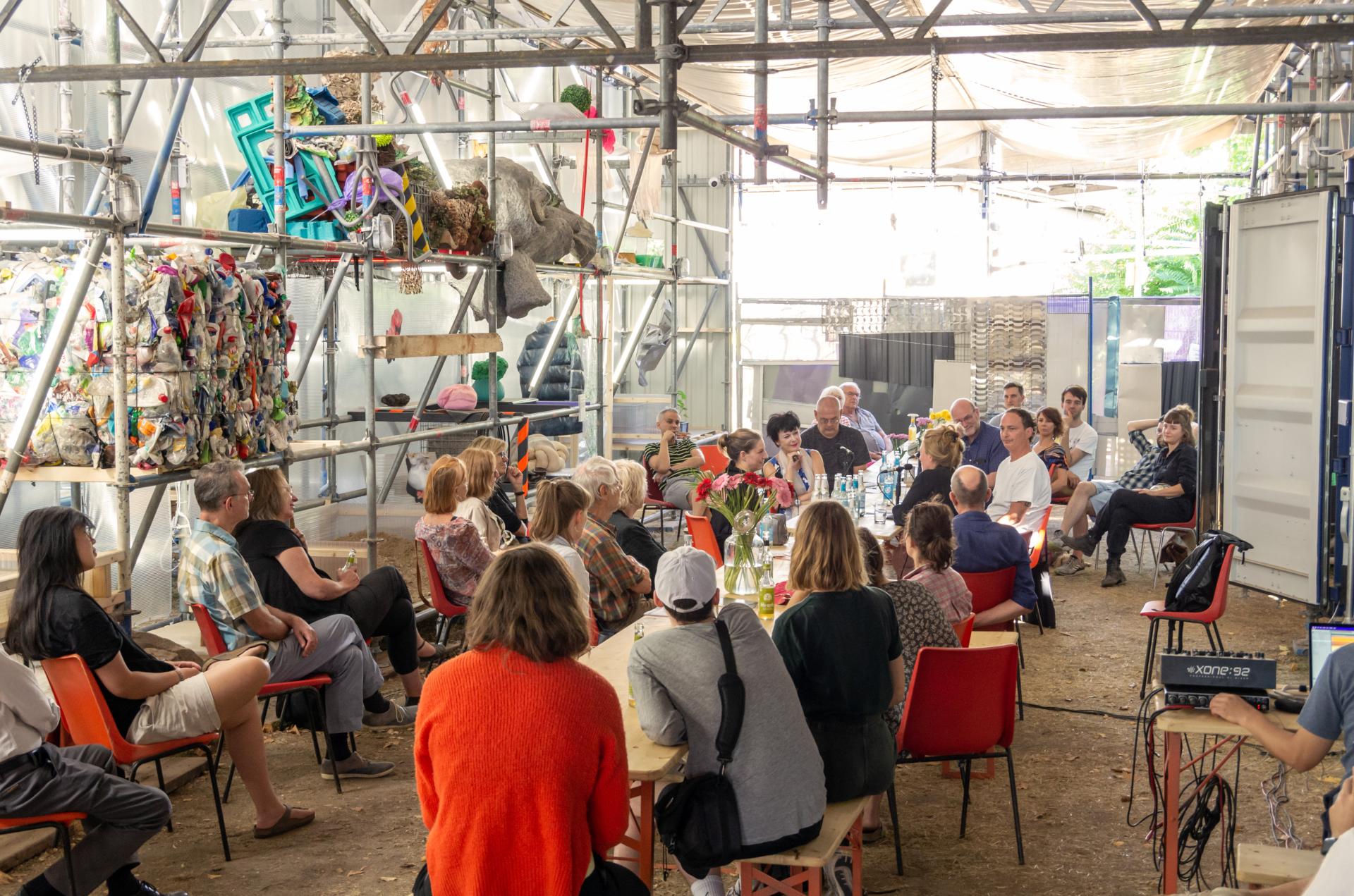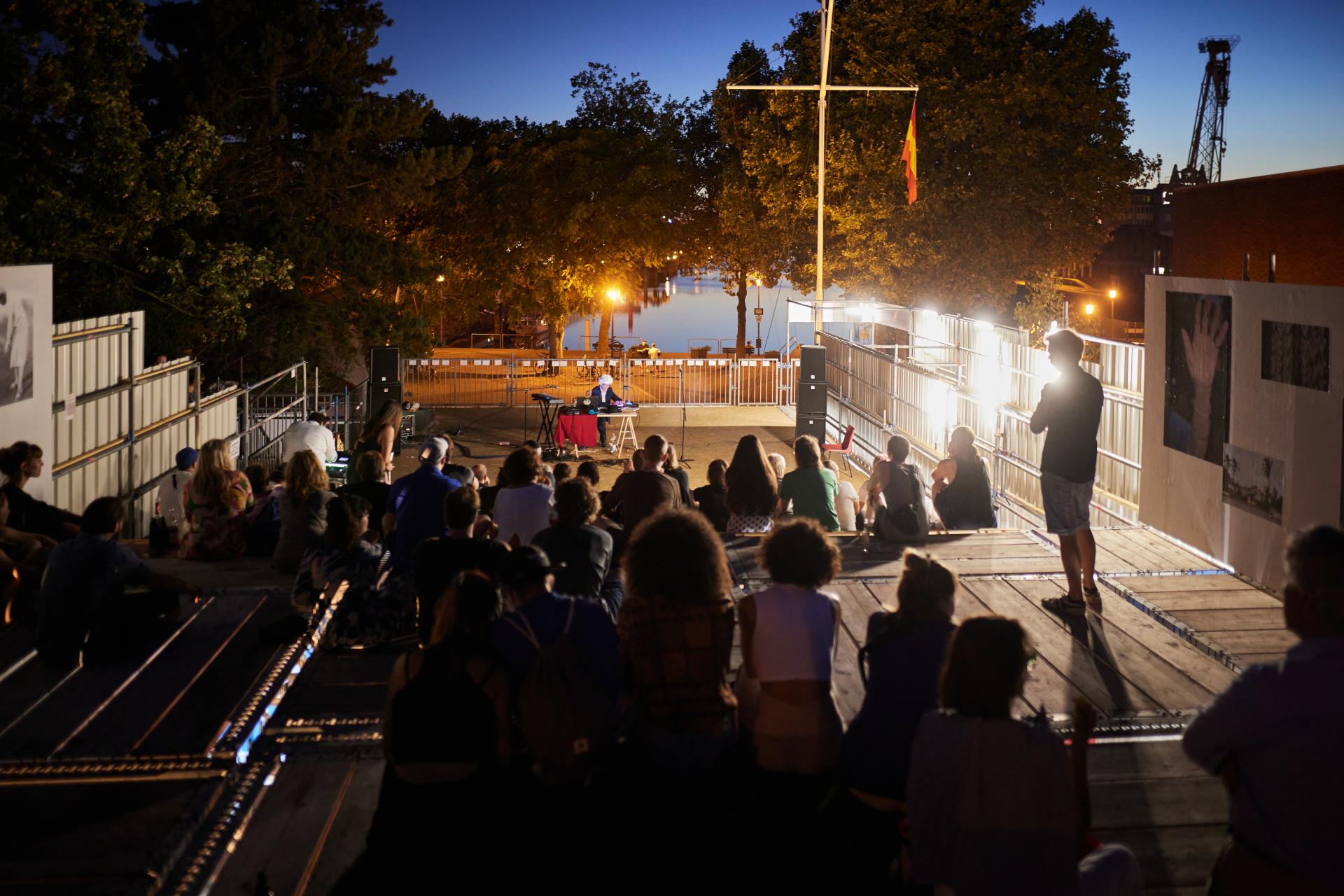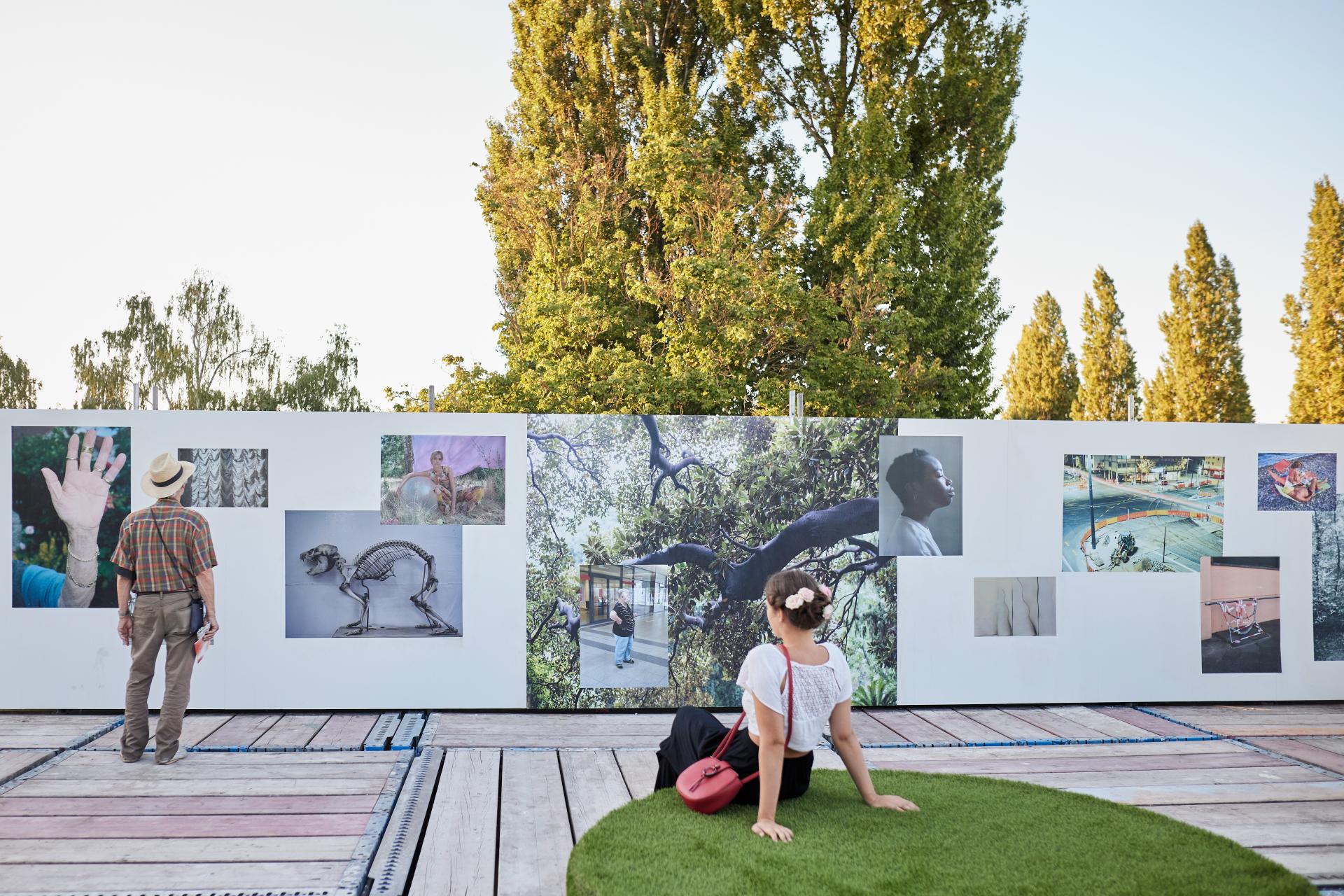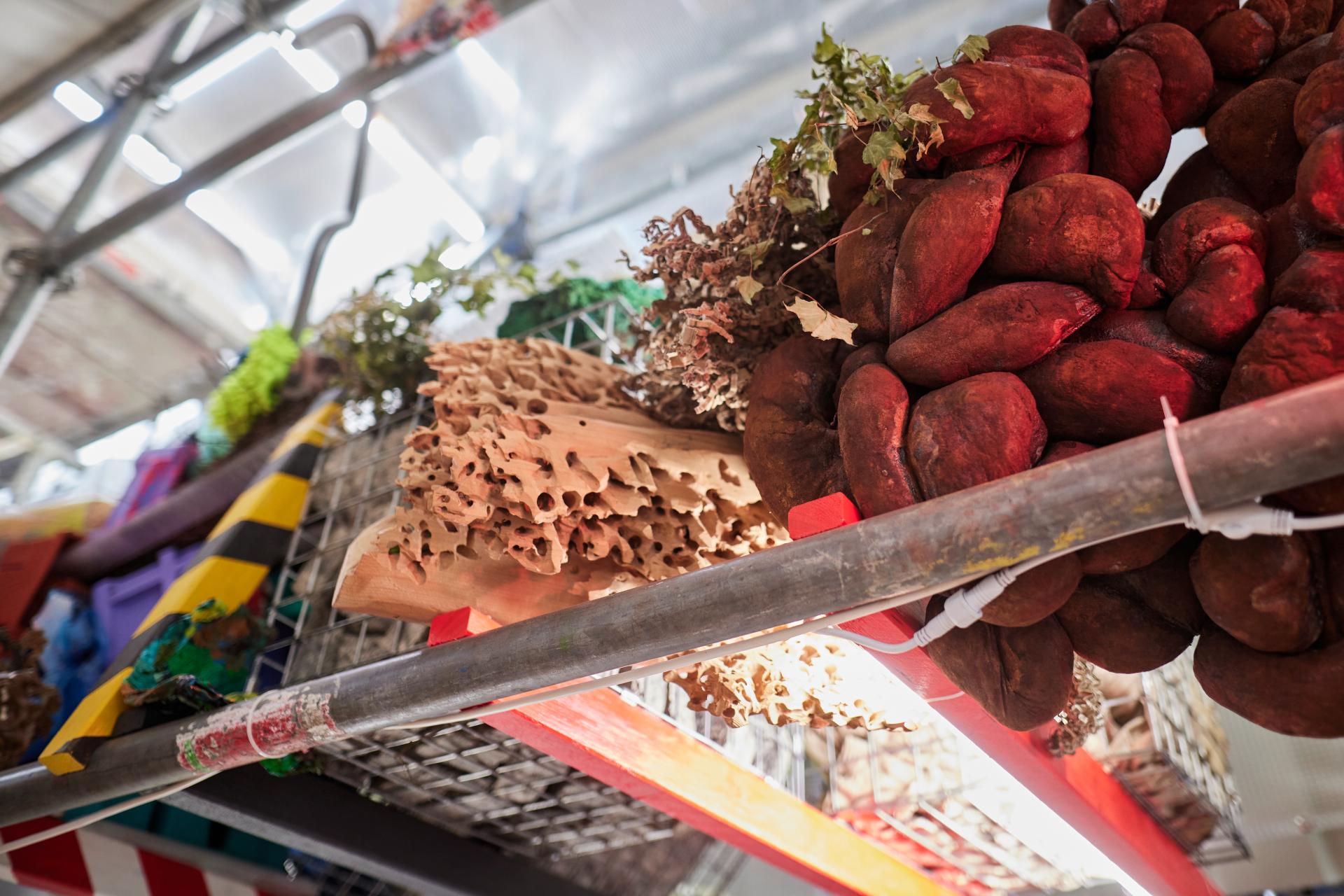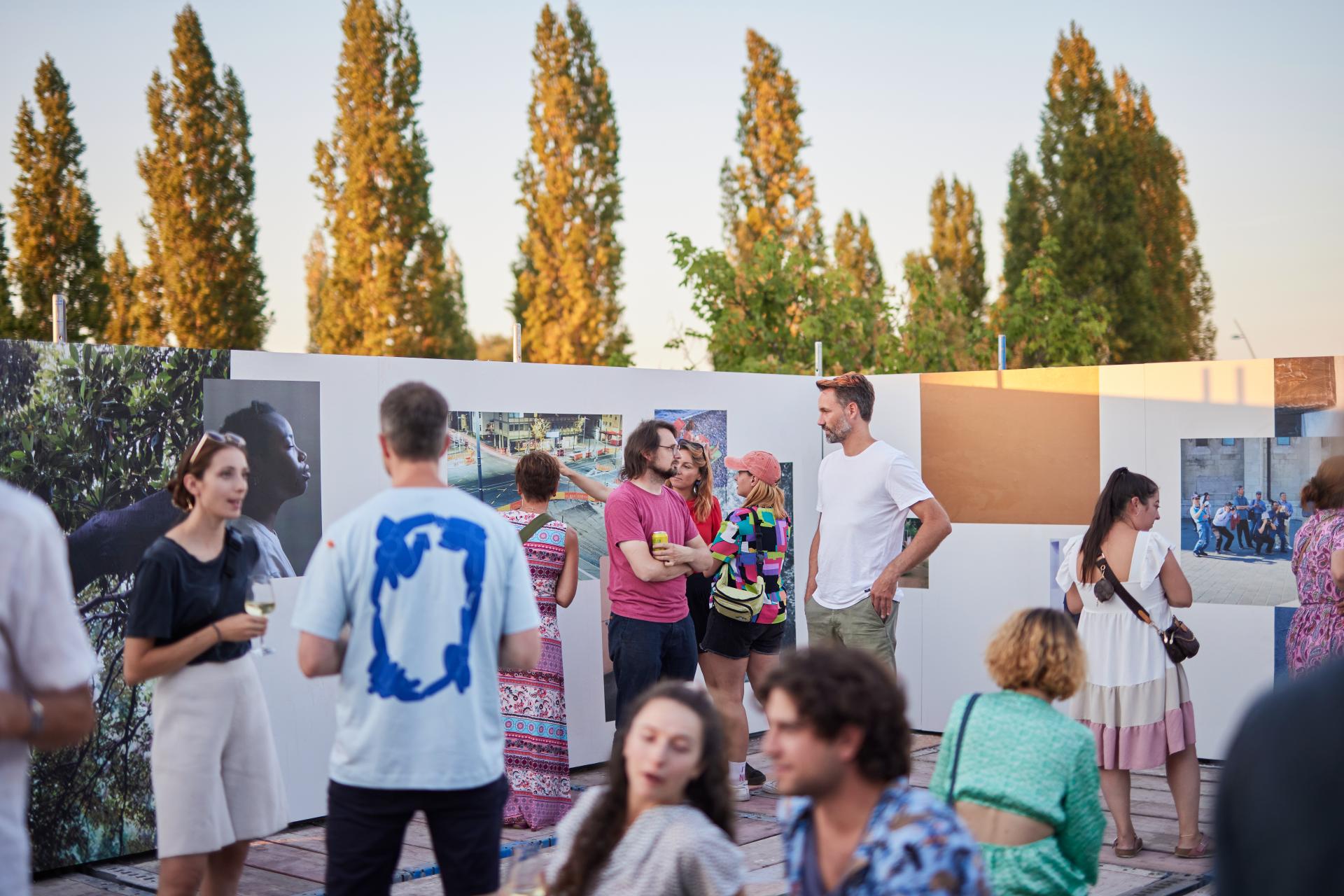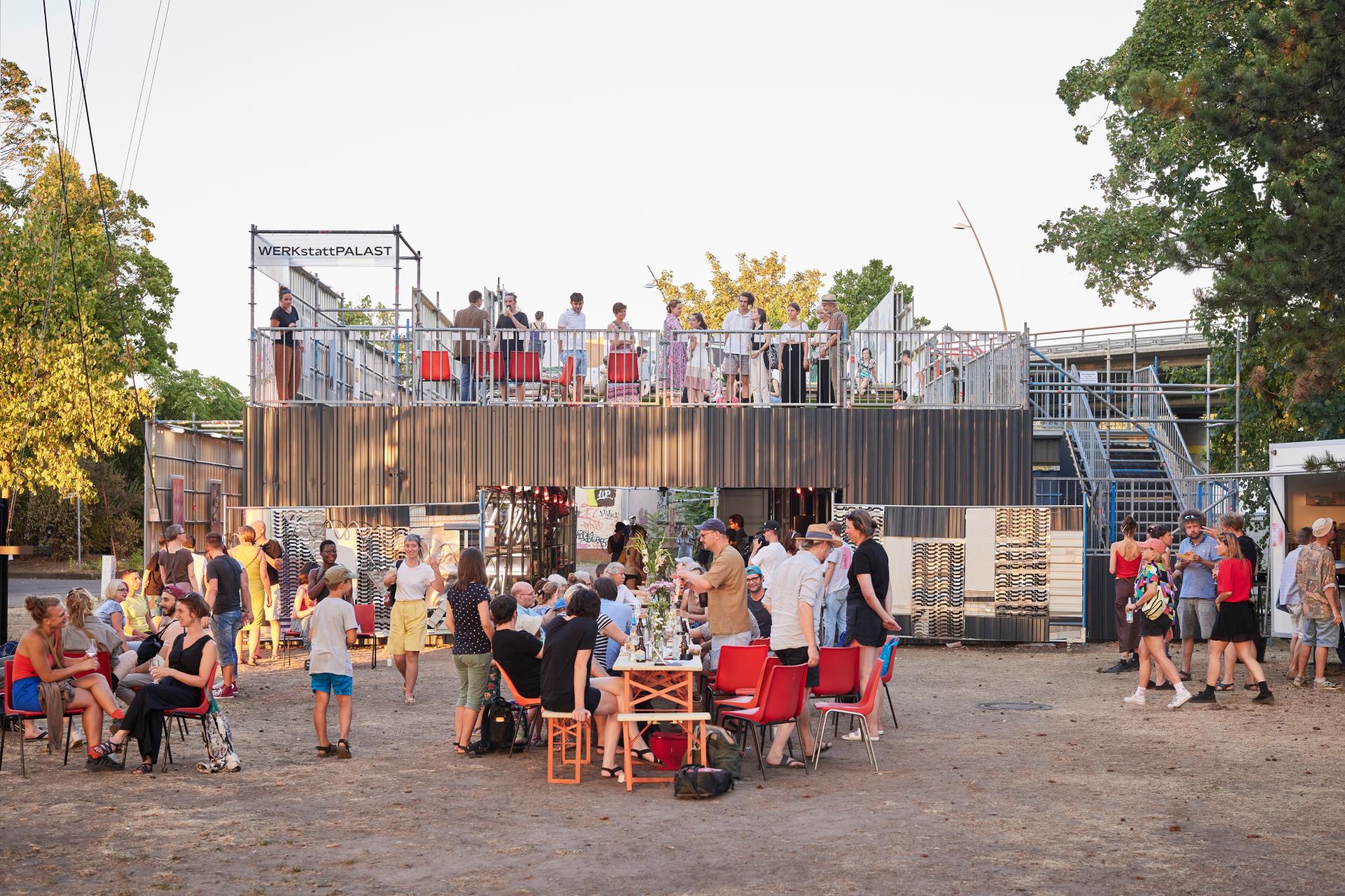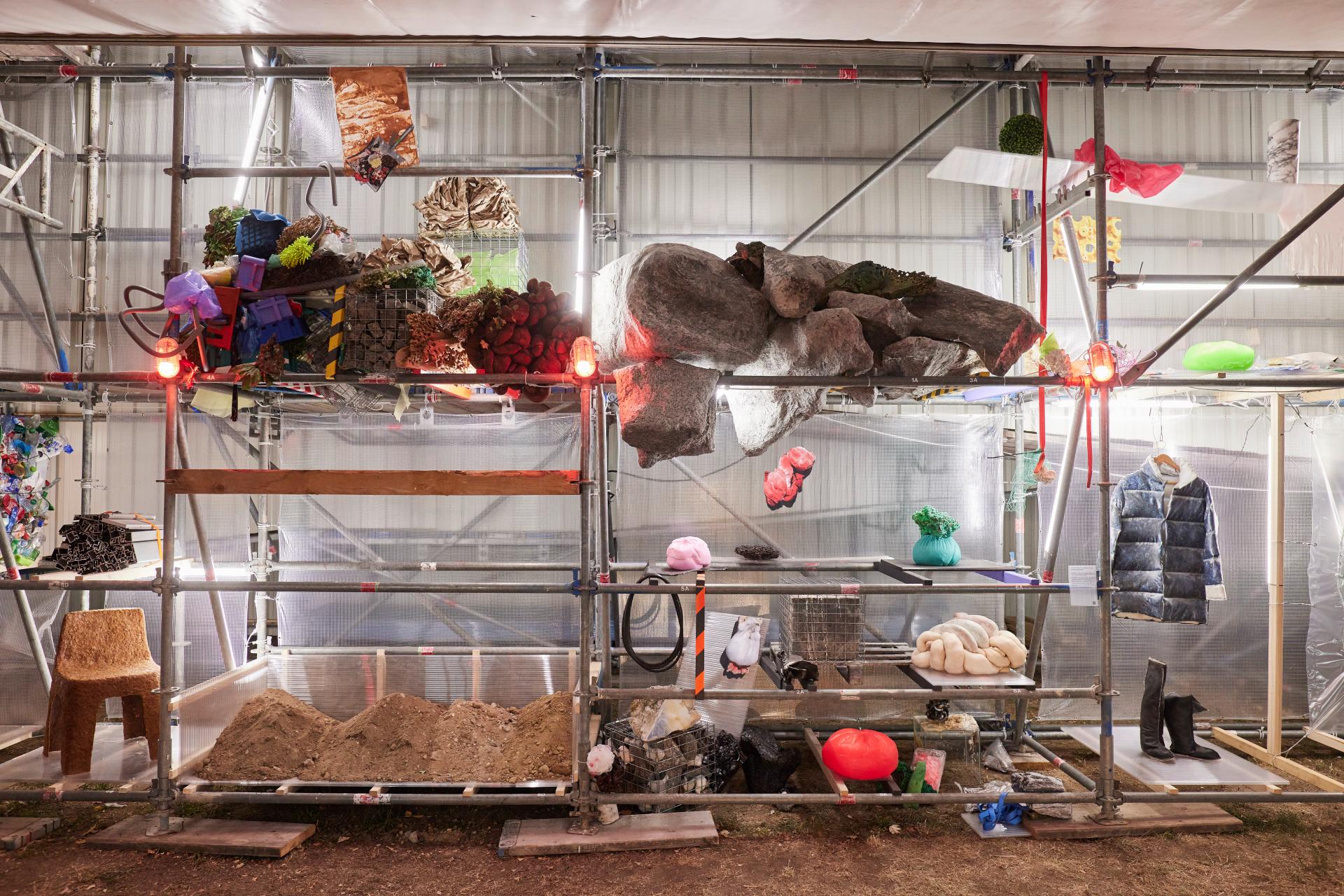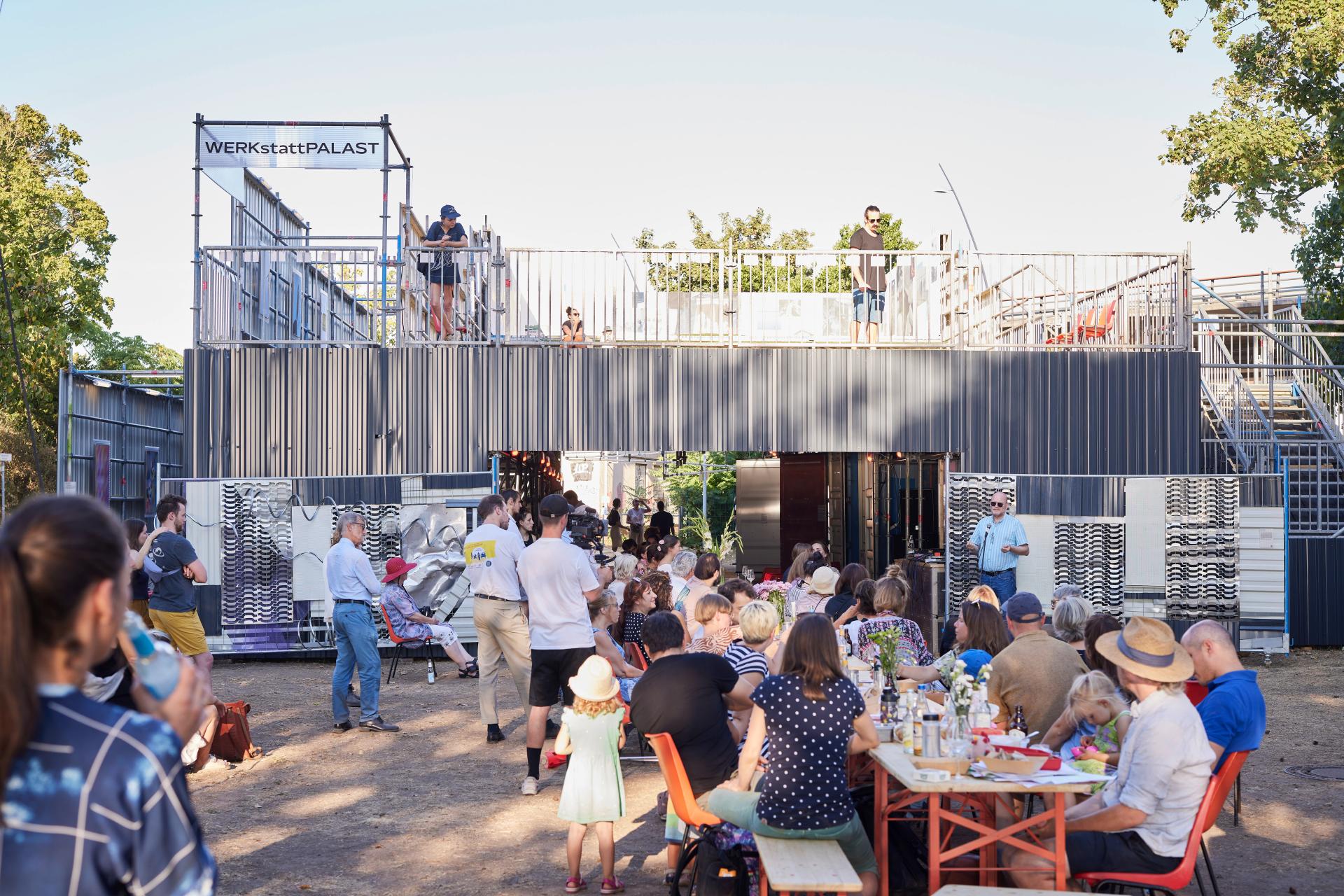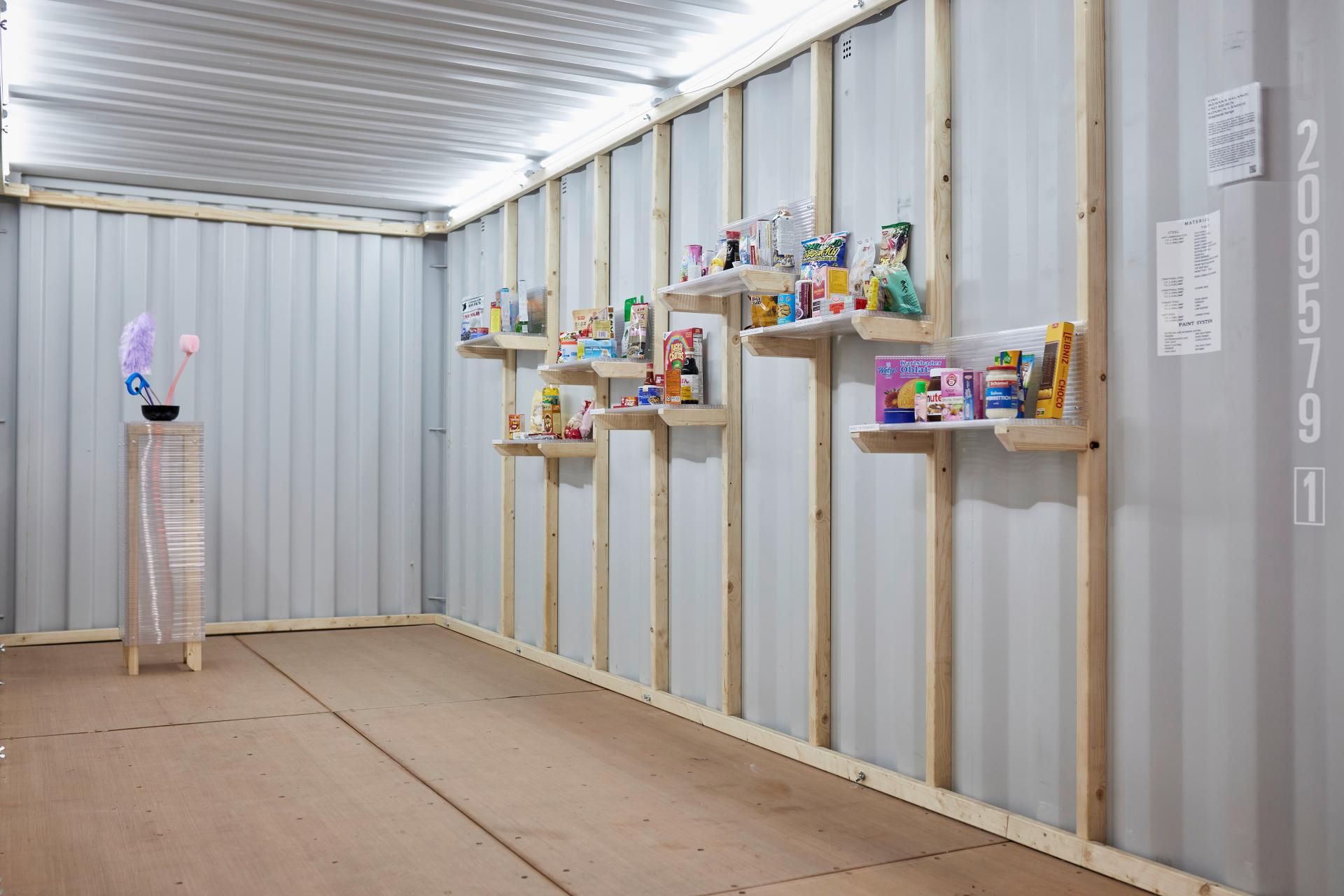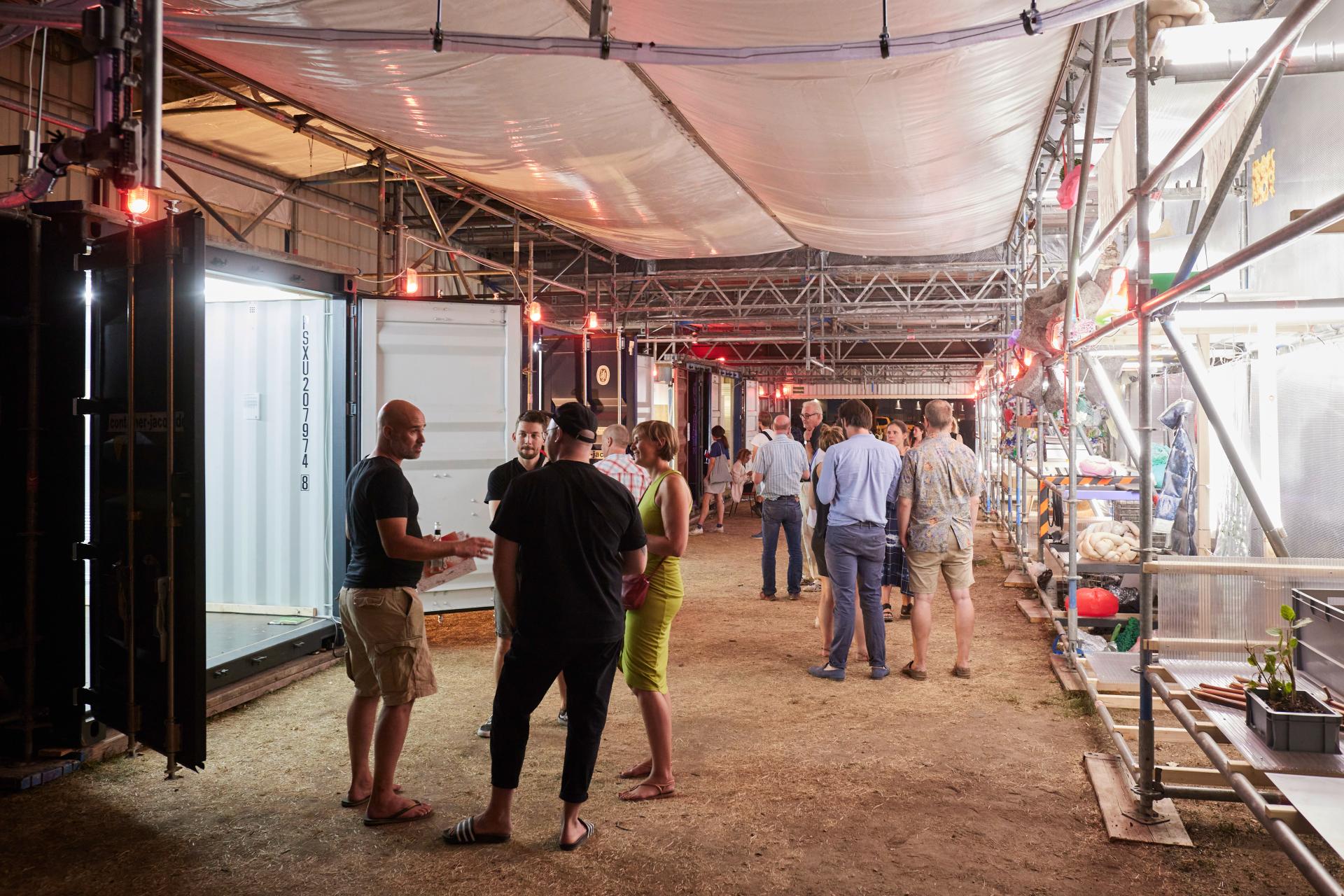Art & Science Festival WERKstattPALAST
Basic information
Project Title
Art & Science Festival WERKstattPALAST
Full project title
WERKstattPALAST – 10-week art and science festival in which the topic of (Infra)STRUCTURE is addres
Category
Regaining a sense of belonging
Project Description
WERKstattPALAST: A 10-week festival uniting Science, Art, and Society and transformed the industrial harbor in a multidirectional platform, that shattered disciplinary boundaries, fueled discourse, and paved the way for sustainable infrastructures. This event unlocked new dimensions of communication and explored (Infra)STRUCTURE from diverse angles. Coordinated by KIT Innovation Hub and ato, it established a unique space where culture, science, and industry converged.
Geographical Scope
Local
Project Region
Karlsruhe, Germany
Urban or rural issues
It addresses urban-rural linkages
Physical or other transformations
It refers to a physical transformation of the built environment (hard investment)
EU Programme or fund
No
Description of the project
Summary
The "WERKSTATTPALAST" project, spanning ten weeks with 95 events and a substantial interdisciplinary exhibition, focused on the theme of "Infrastructures." Motivated by the post-COVID-19 silence and the underrepresentation of art in Citizen-Science projects, the project aimed to highlight the foundational role of infrastructure in society. It advocated for recognizing infrastructure as a crucial element and fostering inclusive dialogue among diverse interest groups.
Situated in the Karlsruhe harbor area, the project utilized purpose-built temporary architecture in collaboration with the KIT Innovation Hub and the art network ato. This platform facilitated converging perspectives on infrastructure, ranging from building science to artistic interpretations. Activities included lectures, dialogue sessions, performances, concerts, workshops, and an exhibition space for artworks on the upper floor. The lower floor featured a material library and a communal table for exchanges among guests.
With active participation from 190 individuals across science, art, society, business, and politics, along with 40 artists, the project addressed global challenges such as climate change, power dynamics, digital systems, and consumer structures. Notably, "WERKSTATTPALAST" was a self-initiated, non-profit endeavor, highlighting its grassroots nature and the creators' dedication to realizing their vision independently.
Through this interdisciplinary approach, the initiative aimed to cultivate constructive conversations and meaningful exchanges, emphasizing the importance of unconventional collaborations and diverse perspectives. By engaging various interest groups, the project sought to initiate a dialogue that could lead to transformative processes, vital for building a more sustainable and interconnected future.
Situated in the Karlsruhe harbor area, the project utilized purpose-built temporary architecture in collaboration with the KIT Innovation Hub and the art network ato. This platform facilitated converging perspectives on infrastructure, ranging from building science to artistic interpretations. Activities included lectures, dialogue sessions, performances, concerts, workshops, and an exhibition space for artworks on the upper floor. The lower floor featured a material library and a communal table for exchanges among guests.
With active participation from 190 individuals across science, art, society, business, and politics, along with 40 artists, the project addressed global challenges such as climate change, power dynamics, digital systems, and consumer structures. Notably, "WERKSTATTPALAST" was a self-initiated, non-profit endeavor, highlighting its grassroots nature and the creators' dedication to realizing their vision independently.
Through this interdisciplinary approach, the initiative aimed to cultivate constructive conversations and meaningful exchanges, emphasizing the importance of unconventional collaborations and diverse perspectives. By engaging various interest groups, the project sought to initiate a dialogue that could lead to transformative processes, vital for building a more sustainable and interconnected future.
Key objectives for sustainability
The concept aims to think in a bridge-building way, to work cooperatively and diversely with different partners and to promote interdisciplinarity in a sustainable way. The core interest of the Innovation Hub was primarily in materials science and the examination of "sustainable infrastructures", while Team ato deals with infrastructure on an artistic level and wants to establish alternative paths for the art world. An important interface, however, lies in the mutual concern to understand infrastructure not only as a structural framework but also on a socio-cultural and social level. The two project initiators agree that visionary and sustainable models (which are urgently needed) can only be created through cooperative collaboration, a process-oriented approach, and interdisciplinary exchange. Only in this way can established structures be rethought or broken up and new visionary scope for action be made possible in the first place. WERKstattPALAST is in equal parts a physical center (place) and a decentralized network (content, actors) that collaborates in an interdisciplinary way with current positions from art, science and the world of building and includes all actors of the "infrastructure production chain". The world we live in is accelerating at an immense pace, and with it all (infra-)structures, (economic) systems, as well as our society. Together, we are challenged to redefine ourselves. In our (digital) time, it is not only a matter of implementing concepts of individual people or producing mass products but also of asking questions about our "today and tomorrow" together and in dialog, and developing possible answers in a process-like manner. The long-term goal is to make citizens the central drivers of an open, creative, and agile culture of innovation and future development through networking. Diverse perspectives offer space for the development of ideas and thus for the creation of something new.
Key objectives for aesthetics and quality
The project was intended to go beyond traditional notions of aesthetics and reveal the beauty in the interplay of art, science and infrastructure. The WERKstattPALAST project offered visitors an immersive and thought-provoking experience. The choice of the venue, the Rheinhafen Karlsruhe, was not random, but was a central component of the concept. The future design and use of the Rhine harbour as part of the urban infrastructure has been the subject of controversial discussions in local politics, business and by citizens for many years. In addition to land use, this also involves questions of sustainable development or operation adapted to current developments (keyword: water level in summer). In addition, the use of the Rhine harbour for cultural projects has not been permitted until now, and the positions of the city and the harbour administration on these concerns have hardened. The WERKstattPALAST project submitted, however, convinced those responsible with its combination of science, art and actual discourse on industry-relevant topics. In this way, the temporary, physical location of the project in the
Rhine harbour could be developed as an inviting and scalable starting point, from which an immaterial network was built that deals with questions of sustainable (infra-)structures in our society - beyond the project period in 2022. The ′breaking open′ of an existing infrastructure and an opening of the district to a broad audience.
In practical terms, a flying architecture was designed, built and equipped with a material library and other exhibition contributions in the Rhine harbour of Karlsruhe. A ten-week programme with various contributions from the fields of science, technology and art was set up and implemented.
Rhine harbour could be developed as an inviting and scalable starting point, from which an immaterial network was built that deals with questions of sustainable (infra-)structures in our society - beyond the project period in 2022. The ′breaking open′ of an existing infrastructure and an opening of the district to a broad audience.
In practical terms, a flying architecture was designed, built and equipped with a material library and other exhibition contributions in the Rhine harbour of Karlsruhe. A ten-week programme with various contributions from the fields of science, technology and art was set up and implemented.
Key objectives for inclusion
A place for everyone, the local community and beyond. For the first time, visitors to the WERKstattPALAST had the opportunity to stay in the harbour for a longer period
of time, which was well received throughout. At a self-built 25-metre-long table, people were able to engage in low-threshold conversation and exchange ideas about what they had seen in an inviting atmosphere. The speechlessness in our society has continued to grow during the pandemic in the last two years. There are too few places and contact points where people can exchange and share newly acquired knowledge across old and/or newly created boundaries. In particular,
there is an urgent need for platforms that are not owned by a single discipline or field, but places that are shared and played upon by all. Only in this way can we develop a
culture of discourse and consensus adapted to social change, which is an indispensable prerequisite for a sustainable society. Controversial discussions on fundamental issues of personal freedom have gone viral in social media. The simplification of complex technical processes beyond recognition or source-less conspiracy theories show that a classic ′one-directional′ approach quickly leads to the fact that only those groups can be won over for constructive participation who approach this format with a certain openness from the outset. To overcome these limitations, ′multidirectional′ approaches are needed that use different content and methodological formats to lead a representative number of social and scientific-technical groups into the actual substantive debate. These upstream steps support the development of a better understanding for others and create a basis of trust, which is an essential prerequisite for an objective and productive discussion. A space for knowledge exchange and cultural experiences accessible to people from all walks of life. With the WERKstattPalast an integrative space could be created without compromising on quality and experience.
of time, which was well received throughout. At a self-built 25-metre-long table, people were able to engage in low-threshold conversation and exchange ideas about what they had seen in an inviting atmosphere. The speechlessness in our society has continued to grow during the pandemic in the last two years. There are too few places and contact points where people can exchange and share newly acquired knowledge across old and/or newly created boundaries. In particular,
there is an urgent need for platforms that are not owned by a single discipline or field, but places that are shared and played upon by all. Only in this way can we develop a
culture of discourse and consensus adapted to social change, which is an indispensable prerequisite for a sustainable society. Controversial discussions on fundamental issues of personal freedom have gone viral in social media. The simplification of complex technical processes beyond recognition or source-less conspiracy theories show that a classic ′one-directional′ approach quickly leads to the fact that only those groups can be won over for constructive participation who approach this format with a certain openness from the outset. To overcome these limitations, ′multidirectional′ approaches are needed that use different content and methodological formats to lead a representative number of social and scientific-technical groups into the actual substantive debate. These upstream steps support the development of a better understanding for others and create a basis of trust, which is an essential prerequisite for an objective and productive discussion. A space for knowledge exchange and cultural experiences accessible to people from all walks of life. With the WERKstattPalast an integrative space could be created without compromising on quality and experience.
Results in relation to category
Our project, WERKstattPALAST, has significantly impacted science communication by motivating and involving scientists, artists, and the public while fostering interdisciplinary collaboration. Here are the key points for our application category:
- Motivating and Involving Diverse Participants: WERKstattPALAST effectively engaged young scientists, artists, and citizens. Recognizing the potential for interdisciplinary exchange among early-stage professionals, we actively involved individuals with varying expertise and perspectives in program development, promoting a culture of discourse and consensus.
- Interdisciplinary Collaboration: Our project promoted collaboration among scientists from KIT HUB, artists from ato, and citizens. This bridged the gap between the artistic and scientific worlds, resulting in enriching discussions that broke down traditional disciplinary boundaries, thus creating an open and inclusive environment.
- Engagement with the Public: WERKstattPALAST facilitated open dialogue with the public on sustainable infrastructure. This two-way exchange allowed citizens to learn about infrastructure issues and experts to understand public perceptions, making science more accessible and relevant to society.
- Enriching Discussions: Spontaneous discussions at open tables were a highlight, allowing citizens, scientists, and artists to interact, share perspectives, and learn from each other. These discussions promoted mutual exchange of ideas, contributing to a more inclusive and informed society.
In summary, WERKstattPALAST has improved science communication by engaging people with differing expertise and perspectives, fostering interdisciplinary collaboration, engaging the public, and facilitating enriching discussions. While initiated by artists and scientists, the project was designed to allow all citizens to contribute their expertise and perspectives, creating an inclusive environment for knowledge sharing and mutual enrichment.
- Motivating and Involving Diverse Participants: WERKstattPALAST effectively engaged young scientists, artists, and citizens. Recognizing the potential for interdisciplinary exchange among early-stage professionals, we actively involved individuals with varying expertise and perspectives in program development, promoting a culture of discourse and consensus.
- Interdisciplinary Collaboration: Our project promoted collaboration among scientists from KIT HUB, artists from ato, and citizens. This bridged the gap between the artistic and scientific worlds, resulting in enriching discussions that broke down traditional disciplinary boundaries, thus creating an open and inclusive environment.
- Engagement with the Public: WERKstattPALAST facilitated open dialogue with the public on sustainable infrastructure. This two-way exchange allowed citizens to learn about infrastructure issues and experts to understand public perceptions, making science more accessible and relevant to society.
- Enriching Discussions: Spontaneous discussions at open tables were a highlight, allowing citizens, scientists, and artists to interact, share perspectives, and learn from each other. These discussions promoted mutual exchange of ideas, contributing to a more inclusive and informed society.
In summary, WERKstattPALAST has improved science communication by engaging people with differing expertise and perspectives, fostering interdisciplinary collaboration, engaging the public, and facilitating enriching discussions. While initiated by artists and scientists, the project was designed to allow all citizens to contribute their expertise and perspectives, creating an inclusive environment for knowledge sharing and mutual enrichment.
How Citizens benefit
Involving citizens and civil society was not just an afterthought in the project but rather a fundamental component of its design. Social transformation processes require an intensive discourse between all social groups
and thus the people they represent. Only in this way can individuals‘ ideas about the futureand potential be introduced into processes that are capable of consensus. This has become more difficult today, as instead of discourse, the focus is increasingly on confrontation,
which divides societies and hinders social change more than, for example, delayed political decisions, limited social structures or a lack of money. While between science and society a critical discourse is often only possible in a highly sensitive field of tension,
over the last 20 years an artistic research practice has developed from art that is able to question and criticise science without falling into the realm of conspiracy theory or general scepticism of science. The transdisciplinary concept of the ′WERKstattPALAST′ was developed to counteract the aforementioned lack of discourse and dialogue, which sometimes leads to resignation. The project can thus be understood
as a practical approach to create a ′multidirectional access′ between science, artistic
practice and society on an equal footing. It is indispensable to create places for different
approaches and opinions whose encounters not only reveal differentiations but also
commonalities and enable the joint development of sustainable (infra-)structures. This is why places like these are so important to us for imparting knowledge at eye-level.
and thus the people they represent. Only in this way can individuals‘ ideas about the futureand potential be introduced into processes that are capable of consensus. This has become more difficult today, as instead of discourse, the focus is increasingly on confrontation,
which divides societies and hinders social change more than, for example, delayed political decisions, limited social structures or a lack of money. While between science and society a critical discourse is often only possible in a highly sensitive field of tension,
over the last 20 years an artistic research practice has developed from art that is able to question and criticise science without falling into the realm of conspiracy theory or general scepticism of science. The transdisciplinary concept of the ′WERKstattPALAST′ was developed to counteract the aforementioned lack of discourse and dialogue, which sometimes leads to resignation. The project can thus be understood
as a practical approach to create a ′multidirectional access′ between science, artistic
practice and society on an equal footing. It is indispensable to create places for different
approaches and opinions whose encounters not only reveal differentiations but also
commonalities and enable the joint development of sustainable (infra-)structures. This is why places like these are so important to us for imparting knowledge at eye-level.
Physical or other transformations
It refers to a physical transformation of the built environment (hard investment)
Innovative character
The implementation of the programme was the responsibility of the team members, i.e. the young scientists and artists. They also acted as moderators for the numerous discussions with guests from science, politics, art, administration and other social groups,
who provided their own contributions for the individual events. In the various formats (e.g. talks, workshops), the same topic (infra)structure was examined from very different positions. Leaving one‘s own ′specialist bubble′ was therefore unavoidable for both academics and artists. Interestingly, the observed opening for other positions was mainly driven by the contributions of the citizens to the discussion. Surprisingly, it became apparent after
only two weeks that contributions from the scientific, artistic and social spheres were being added almost playfully to their own specialist positions. This was not expected until the end of WERKstattPALAST after 10 weeks. Even at the early stage, the boundary between science and art quickly
became more permeable, and those involved got to know the positions, ways of thinking
and working of the partners on concrete problems and issues. With the exception of the actual scaffolding, the flying structures of the WERKstattPALAST were built (and later
dismantled and recycled) by the team, consisting of representatives of KIT HUB and ato.
An intensive exchange between the team members was initiated, especially in the creation
of the material library, which, in addition to the actual materials or better research objects
(e.g. made of steel or concrete), also showed artistic works created with these materials.
who provided their own contributions for the individual events. In the various formats (e.g. talks, workshops), the same topic (infra)structure was examined from very different positions. Leaving one‘s own ′specialist bubble′ was therefore unavoidable for both academics and artists. Interestingly, the observed opening for other positions was mainly driven by the contributions of the citizens to the discussion. Surprisingly, it became apparent after
only two weeks that contributions from the scientific, artistic and social spheres were being added almost playfully to their own specialist positions. This was not expected until the end of WERKstattPALAST after 10 weeks. Even at the early stage, the boundary between science and art quickly
became more permeable, and those involved got to know the positions, ways of thinking
and working of the partners on concrete problems and issues. With the exception of the actual scaffolding, the flying structures of the WERKstattPALAST were built (and later
dismantled and recycled) by the team, consisting of representatives of KIT HUB and ato.
An intensive exchange between the team members was initiated, especially in the creation
of the material library, which, in addition to the actual materials or better research objects
(e.g. made of steel or concrete), also showed artistic works created with these materials.
Disciplines/knowledge reflected
For the implementation of the WERKstattPALAST concept, the KIT Innovation HUB – Prevention in Construction works together with the art scientist, cultural manager and curator Norina Quinte. Scientific content on the topic of (infra)structure was provided by the KIT HUB. Another partner and co-initiator of the project is the continuously growing network ato, which sees itself at the interface of art network, art mediation and agency and strives for new structures of art mediation. The interdisciplinary structure of ato and the KIT HUB provided the opportunities for the wide-ranging WERKstattPALAST. Together, KIT HUB and ato developed the programme and created the conditions for its implementation. The ato network was responsible for the curatorial direction, the exhibition curation and the music concept, as well as a number of programme points relating to social and artistic structures. The KIT HUB was responsible for the content and organisation of discussion rounds and the hosting of workshops. Of particular importance for the implementation of the ′WERKstattPALAST′ was the close cooperation with the public administration of Karlsruhe and the port administration, as this initiative was the first externally organised cultural event on the port grounds. In addition, it was possible to realise a very close accompaniment by the regional press. We have demonstrably made a difference with our communication. More than 5,000 visitors came to WERKstattPALAST. Young and old visited the project and contributed to a perspective-rich dialogue about science and art around the topic. (infra)structures. Thus, after years of controversy between the City of Karlsruhe, Karlsruhe Rheinhafen GmbH and interest groups from Karlsruhe and the surrounding area about the future development and use of the Rhine harbour, a new initiative to solve theidentified problems was stimulated. Various interest groups are asking for a continuation of the project.
Methodology used
The approach of the "WERKstattPALAST" project was founded on creating a collaborative platform that united science, art, and society. We break new ground in communication and develop innovative, bold projects
and formats. 95 individual programme items included
lectures, dialogue rounds, workshops, performances, guided tours, listening sessions, concerts, question rounds and much more. Our approach was to bring people from all areas of society together through a jointly created offer of science and art, so that they could listen to each other and exchange ideas. The programme was realised by about 190 people from a wide range of disciplines. And all this with free admission. New communication formats for the transfer of scientific content were thus tested in diverse and unusual ways and made tangible not only theoretically but also practically. Opportunities for visitors to participate were part of almost all programme items. In addition to the architecture itself, the key to accessible and barrier-free knowledge transfer were numerous artistic contributions, participatory offerings and the design of catering venues. Rather than traditional lecture-style learning, the "WERKstattPALAST" advocated for hands-on, experiential learning that is more engaging, impactful, and transformational.
and formats. 95 individual programme items included
lectures, dialogue rounds, workshops, performances, guided tours, listening sessions, concerts, question rounds and much more. Our approach was to bring people from all areas of society together through a jointly created offer of science and art, so that they could listen to each other and exchange ideas. The programme was realised by about 190 people from a wide range of disciplines. And all this with free admission. New communication formats for the transfer of scientific content were thus tested in diverse and unusual ways and made tangible not only theoretically but also practically. Opportunities for visitors to participate were part of almost all programme items. In addition to the architecture itself, the key to accessible and barrier-free knowledge transfer were numerous artistic contributions, participatory offerings and the design of catering venues. Rather than traditional lecture-style learning, the "WERKstattPALAST" advocated for hands-on, experiential learning that is more engaging, impactful, and transformational.
How stakeholders are engaged
In order to see oneself as an active creator of a sustainable infrastructure, it
was important to address project participants, experts and visitors in a targeted manner and to design the offer in such a versatile way that it functions across disciplines and generations. This was achieved through WERKstattPALAST 2022. It could be clearly seen how visitor, including children with parents repeatedly attended workshops or experienced performances, at the same time getting into conversation with experts, and how older visitors also began to engage with new scientific findings and foreign perspectives. On the other hand, the exchange between the scientists and artists and the guests and visitors led to self-reflection on their own work. The target groups were therefore not only the citizens and guests, but also the project participants from science and art. Only if young, but also established scientists see the exchange with the various social groups as an important contribution to their own work, will not only the taxpayers‘ understanding of the value of scientific work increase, but also the quality of research work.
was important to address project participants, experts and visitors in a targeted manner and to design the offer in such a versatile way that it functions across disciplines and generations. This was achieved through WERKstattPALAST 2022. It could be clearly seen how visitor, including children with parents repeatedly attended workshops or experienced performances, at the same time getting into conversation with experts, and how older visitors also began to engage with new scientific findings and foreign perspectives. On the other hand, the exchange between the scientists and artists and the guests and visitors led to self-reflection on their own work. The target groups were therefore not only the citizens and guests, but also the project participants from science and art. Only if young, but also established scientists see the exchange with the various social groups as an important contribution to their own work, will not only the taxpayers‘ understanding of the value of scientific work increase, but also the quality of research work.
Global challenges
The project, WERKstattPALAST, addresses global challenges through local solutions by focusing on the theme of "infrastructures," which are the backbone of our society. This theme is pivotal because the state of infrastructure, including transport routes, schools, and hospitals, directly impacts the development of our economy and society. However, infrastructure is currently under pressure at all levels, leading to a change in how it is perceived. The concept of transformation and structural change is increasingly relevant across various sectors, such as the economy, politics, art, education, and daily life.
Infrastructure and structural change manifest differently depending on the specific field and educational background, each having its own terminology and understanding. The challenge is bridging these diverse perspectives and creating a platform for exchange. The KIT Innovation HUB and the art initiative ato recognized the need to develop an interdisciplinary and cross-thematic platform where representatives from science, art, and the general public could come together. This led to the creation of WERKstattPALAST, which serves as a practical means to overcome disciplinary boundaries and enhance communication on pressing scientific and socially relevant topics across all segments of society.
By offering a model for addressing these challenges at the local level, WERKstattPALAST has the potential to influence and inspire similar initiatives globally. It demonstrates that principles like sustainability, interdisciplinary collaboration, inclusivity, stakeholder engagement, and innovation can be integrated into local projects to create meaningful impact. The project serves as a beacon of how local efforts can contribute to addressing global challenges, especially those related to infrastructure and structural change, by fostering collaboration, understanding, and engagement across diverse sectors and communities.
Infrastructure and structural change manifest differently depending on the specific field and educational background, each having its own terminology and understanding. The challenge is bridging these diverse perspectives and creating a platform for exchange. The KIT Innovation HUB and the art initiative ato recognized the need to develop an interdisciplinary and cross-thematic platform where representatives from science, art, and the general public could come together. This led to the creation of WERKstattPALAST, which serves as a practical means to overcome disciplinary boundaries and enhance communication on pressing scientific and socially relevant topics across all segments of society.
By offering a model for addressing these challenges at the local level, WERKstattPALAST has the potential to influence and inspire similar initiatives globally. It demonstrates that principles like sustainability, interdisciplinary collaboration, inclusivity, stakeholder engagement, and innovation can be integrated into local projects to create meaningful impact. The project serves as a beacon of how local efforts can contribute to addressing global challenges, especially those related to infrastructure and structural change, by fostering collaboration, understanding, and engagement across diverse sectors and communities.
Learning transferred to other parties
One of the significant outcomes of the collaborative project between science and art is the realization that tangible and dialogical forms of engagement can only succeed when both parties are involved in the core team from the outset. Managing as a team enables a discourse on equal footing and a project implementation that satisfies everyone. The knowledge management framework established can be transferred to numerous other projects.
Requirements for replication:
• A dedicated team of enthusiastic artists and scientists
• A compelling and socially relevant issue
• Stakeholders representing various facets of the topic, including politics, industry, and the community
• An inspiring physical location or space
• An adaptable and engaging program
• Guest contributions
• Sponsorship support
The "WERKstattPALAST" project pioneered a collaborative model between science and art, ensuring both are core team members from the start. The knowledge management framework established is a transferable template. Key elements, like the collaborative platform and communal table, offer potential for replication in various settings. It serves as a blueprint inspiring global communities to establish platforms for interdisciplinary conversations.
The project's replicability lies in its adaptable design, offering a local solution with global relevance. The methodology, emphasizing collaboration and inclusivity, stands out as its most transferable element. This approach can guide artist-scientist teams in addressing urgent societal issues in their communities, using the successful framework of "WERKstattPALAST" for impact.
Requirements for replication:
• A dedicated team of enthusiastic artists and scientists
• A compelling and socially relevant issue
• Stakeholders representing various facets of the topic, including politics, industry, and the community
• An inspiring physical location or space
• An adaptable and engaging program
• Guest contributions
• Sponsorship support
The "WERKstattPALAST" project pioneered a collaborative model between science and art, ensuring both are core team members from the start. The knowledge management framework established is a transferable template. Key elements, like the collaborative platform and communal table, offer potential for replication in various settings. It serves as a blueprint inspiring global communities to establish platforms for interdisciplinary conversations.
The project's replicability lies in its adaptable design, offering a local solution with global relevance. The methodology, emphasizing collaboration and inclusivity, stands out as its most transferable element. This approach can guide artist-scientist teams in addressing urgent societal issues in their communities, using the successful framework of "WERKstattPALAST" for impact.
Keywords
Transforming the built environment: (infra)structure understanding
Interdisciplinarity: building bridges between art and science
Technology and knowledge transfer with low-threshold access
Material library: basic element for construction work up to sustainable design objects and materials
Inclusivity: Social transformation processes

